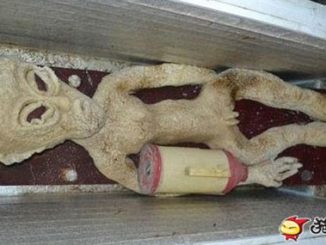In 2017, during a routine renovation at the Little Museum of Nykøbing Falster, an unexpected revelation emerged from the depths of history. Workers stumbled upon a hidden door that led to a concealed chamber, a discovery that would forever change the narrative of this charming museum. Behind this door lay a trove of crates, documents, and sketches that painted a vivid portrait of the house’s former owner, Cornelius S. C. Rödder. As researchers delved into this newfound collection, they unearthed not only artifacts but a story that encapsulated the essence of Nykøbing Falster’s rich cultural heritage. Join us as we explore the incredible journey of this hidden room and its implications for understanding our past.
The Discovery: A Door to History
The initial excitement surrounding the discovery of the concealed chamber was palpable. Renovation crews, working diligently to update the museum’s facilities, stumbled upon an unassuming door behind a wall. Curiosity piqued, they opened it to reveal a dimly lit room that had seemingly been untouched for decades. Dust-covered crates lined the walls, and the air was thick with the scent of aged paper and forgotten memories.
The significance of this room quickly became apparent. Inside were crates filled with old documents, including letters, sketches, and even personal items belonging to Cornelius S. C. Rödder, a notable figure in Nykøbing Falster’s history. Rödder was known not only for his contributions to local commerce but also for his passion for the arts and architecture. The chamber offered a glimpse into his life, revealing insights into the societal context of his time and his influence on the town’s development.
As images of the discovery circulated, viewers were captivated by the unique artifacts that emerged from the shadows. Each crate, filled with meticulously preserved items, served as a window into the past, sparking a renewed interest in the local history and the significance of the museum itself.
Cornelius S. C. Rödder: A Man of Many Talents
To fully appreciate the importance of the hidden chamber, it’s essential to understand the life of Cornelius S. C. Rödder. Born in the early 19th century, Rödder was a polymath with diverse interests, from commerce to the fine arts. He played a significant role in the economic growth of Nykøbing Falster, contributing to its development as a vibrant town.
Rödder was not just a businessman; he was an innovator and a patron of the arts. His love for architecture was evident in the buildings he commissioned, many of which still stand today. The sketches found in the hidden chamber included designs for structures that, if built, would have transformed the town’s landscape. These plans, alongside personal letters, provided a glimpse into Rödder’s vision for Nykøbing Falster and his aspirations for its future.
As researchers sifted through the contents of the chamber, they began to piece together Rödder’s multifaceted life. The collection included correspondences that revealed his thoughts on local governance, community development, and even his musings on artistic expression. This newfound knowledge not only enriched the museum’s exhibits but also encouraged local residents to take pride in their heritage and recognize the impact of historical figures like Rödder on their community.
A Revival of Local Heritage
The discovery of the hidden chamber has sparked a renaissance of interest in Nykøbing Falster’s history. The museum has embraced this opportunity to educate the public about the significance of its findings. Guided tours now include special segments dedicated to Rödder’s legacy, showcasing not only the artifacts but also the broader context of the era in which he lived.
In addition to the tours, the museum has hosted lectures and workshops focusing on the historical significance of the documents and artifacts. Local schools have partnered with the museum to incorporate the discoveries into their curriculums, fostering a sense of connection between students and their town’s history. This initiative has not only educated the younger generation but has also encouraged community involvement and a deeper appreciation for local heritage.
Images from the hidden chamber have also made their way into local media, sparking discussions and dialogues about the importance of preserving history. Social media campaigns have showcased the museum’s efforts, drawing attention from history enthusiasts and tourists alike. The Little Museum of Nykøbing Falster has become a beacon of local pride, a place where the past and present converge, reminding visitors of the stories that shape their identities.
The Broader Implications of Ancient Discoveries
As we marvel at the hidden treasures of Cornelius S. C. Rödder, it’s important to reflect on the broader implications of such discoveries. The unearthing of forgotten artifacts has become a theme in archaeological and historical research worldwide. Each discovery, much like Rödder’s hidden chamber, offers insights into the lives of those who came before us, revealing the intricacies of their daily lives, aspirations, and challenges.
Ancient discoveries often serve as catalysts for revitalizing interest in local histories. They remind us of the importance of preserving our heritage, not only for academic purposes but also for fostering a sense of identity within communities. As we uncover layers of history, we gain a deeper understanding of the societal dynamics that have shaped our present.
Furthermore, the process of discovery encourages collaboration among historians, archaeologists, and local communities. By sharing knowledge and resources, we can create a more comprehensive narrative that honors the complexities of our shared past. The lessons learned from Rödder’s story resonate beyond Nykøbing Falster; they serve as a reminder that history is a living entity, continually evolving as we uncover new chapters.
Conclusion: A Legacy of Discovery
The hidden chamber at the Little Museum of Nykøbing Falster has opened a new chapter in the understanding of the town’s history. The artifacts found within have not only illuminated the life of Cornelius S. C. Rödder but have also rekindled a passion for local heritage among residents and visitors alike. This extraordinary discovery serves as a powerful reminder of the significance of preserving history and the stories that bind us together.
As we reflect on the importance of such findings, we are reminded that history is not merely a collection of dates and events; it is a tapestry woven from the lives and experiences of those who came before us. The hidden door, once a mere wall, has become a gateway to understanding, inspiring us to cherish our past while forging a path toward a future rich with knowledge and appreciation for our shared heritage.
For those intrigued by this remarkable discovery, we invite you to explore the images that accompany this journey into the past. Witness the treasures that lie within the hidden chamber and allow the legacy of Cornelius S. C. Rödder to inspire you, just as it has inspired a community eager to embrace its history.


